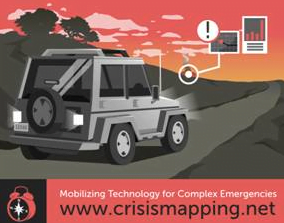Ed note: The report Disaster Relief 2.0: The Future of Information Sharing in Humanitarian Emergencies analyzes how the humanitarian community and the emerging volunteer and technical communities worked together in the aftermath of the 2010 earthquake in Haiti, and recommends ways to improve coordination between these two groups in future emergencies. The UN Office for the Coordination of Humanitarian Affairs (OCHA), together with the United Nations Foundation and Vodafone Foundation Technology Partnership, commissioned the report, which was researched and written by a team at the Harvard Humanitarian Initiative.
The Disaster Relief 2.0 Blog Series provides a public forum for people from both the humanitarian and volunteer and technical communities to discuss ideas in this report and the future of disaster relief.
You can follow conversations about the report on Twitter using the hashtag #DisasterTech and on the UN Foundation’s Facebook page. Readers can submit questions to the report’s authors through those channels; a transcript with answers to select questions will be published on UN Dispatch on April 11, 2011.
Leveraging the power of new technologies, local media and local communities in humanitarian responses
By Jacobo Quintanilla
In Haiti, local citizens and communities affected by the Jan 2010 earthquake participated in the relief effort in unprecedented ways. Through social media and communication tools, this local participation was a revolution in humanitarian aid. Despite the many question marks and variables still to be addressed on this front, there are two main outcomes that deserve to be highlighted.
One is that for the first time ever the volunteer and technology communities engaged in a very significant and permanent manner in a humanitarian operation. Ushahidi, Crisis Mappers, Crisis Commons and OpenStreetMap engaged volunteers from around the world to connect with responders and individuals on the ground through mobile and online tools. This level of input was new and valuable, and deserves the attention and inclusion that it is already getting from the more “traditional” aid community.
Secondly, and even more importantly, the humanitarian community is progressively realizing that responses to crises are too often undermined by a lack of information among the affected population. When a crisis hits, outside aid agencies simply don’t know enough about the local context, the local media landscape, or how information is consumed, to be able to disseminate life-saving information immediately and gather critical feedback from affected communities. Understanding and utilizing that information ecosystem is precisely what Internews, in partnership with local media, local populations and the humanitarian community, tries to do in all our humanitarian media projects around the world.
Two of the most important channels for communicating information during crises are the existing local media, known and trusted by the local population, and the emerging mobile Information and Communication Technologies (ICT). We saw this in Haiti, documented in the report “Lessons from Haiti: Media, information Systems and Communities.
However, despite a great display of potential in the response to the earthquake in Haiti, new technologies, humanitarians, local media and affected populations have yet to connect in a predictable, reliable, and sustainable manner to improve the effectiveness of relief operations and increase community resilience. The lack of communication also undermines transparency and accountability of humanitarian actors and makes the people we serve feel further disengaged from the aid response.
As a community, we need to invest energy, expertise and resources into increasing the capacity of local media and local communities to prepare and respond to disasters effectively. In today’s 2.0 context, this includes understanding the effective utilization of a variety of new technology and social media tools to ensure that local media and local communities are better equipped to be the first responders in any emergency or disaster. Internews efforts to connect community radio stations by mobile network in Central Africa Republic and enable journalists in Kenya to use FrontlineSMS and Ushahidi outside of crisis situations are ways we’re working to build this capacity locally.
Emergencies are not the best time to experiment with untested initiatives. We learned in Haiti that trying to introduce new technologies during an active operation can be unnecessarily frustrating, ineffective, and even a disruptive exercise. This was highlighted, along with many of the important achievements and opportunities for partnership and dialogue between the humanitarian and the technology community, in the report Disaster Relief 2.0: The Future of Information Sharing in Humanitarian Emergencies.
We need to know what tools work and what processes they can improve. The key component is still to figure our how communication tools and processes can be further localized to serve the needs of local communities. This effort takes specific investments of time and resources in advance of the next disaster.
We may never be truly ready for an emergency, but we can help local communities and local media to be better prepared. We also need to keep in mind that we still need to get the low-tech solutions right first. At the end of the day, everything goes back to basics: human interaction.
Jacobo Quintanilla is Humanitarian Director at Internews, an international media development organization, and Board Member of the infoasaid project, an Internews/BBC World Service Trust joint initiative that aims at improving how aid agencies communicate with disaster affected communities. Jacobo was part of the Internews Emergency Response Team to the January 2010 earthquake in Haiti, and later became the first Coordinator of Communicating with Disaster Affected Communities (CDAC) in Haiti. In 2011, Internews launched a new Center on Media, Innovation, Research & Learning aimed at maximizing the potential of digital technologies and innovative approaches to solve new challenges in the rapidly changing global information and communication landscape.
